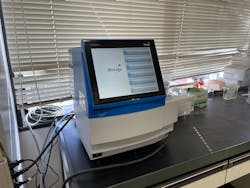Researchers from Osaka University, Japan, have used microwave radiation and a calcium hydroxide catalyst to selectively produce sugars from formaldehyde.
Known as the formose reaction, this classic chemical synthesis follows two steps, eventually forming a complex mixture of sugars and sugar alcohols. However, these need separating for further industrial use.
The new Osaka work both speeds up and improves the selectivity of the formose reaction. It produces just two sugars — a hexose and a heptose — with a reaction yield of nearly 100%.
Their version of the reaction involves irradiating a 5mL aqueous solution of formaldehyde containing calcium hydroxide catalyst with 2.45 GHz microwaves for one minute at 150⁰C.
“The chemicals industry has a sustainability problem.”
With the two products being readily purified and the straightforward reaction design reported in a recent issue of RSC Advances, the Osaka researchers believe the new reaction will help improve the sustainability of chemical feedstock production and prove invaluable if scaling up to larger reaction volumes can be achieved.
“We hypothesize that the formose reaction in our system proceeds substantially on the surface of calcium hydroxide crystallites in the reaction mixture,” says Akihito Hashidzume, a professor with the Department of Macromolecular Science at Osaka University and lead author of the study. “Given that the formose reaction can also proceed on mineral or meteorite surfaces, our work also has intriguing possible implications for understanding the prebiotic synthesis of sugars,” he adds.
Hashidzume’s team will continue to focus on the formose reaction, with two priorities.
“First is to improve the yield with the calcium hydroxide catalyst using different, higher-power microwave reactors and by optimizing the purification procedure. Second, is to obtain sugars using other catalysts. Our preliminary data indicated that the products are somehow dependent on the catalyst. If we get a grant, we will continue this project,” he explains.
Hashidzume is particularly keen to pursue the microwave reactor technology. “It’s one of the most important parameters, but we could not choose the wavelength used freely because of regulations under the [Japanese] Radio Act. So, after getting a grant, we would like to collaborate with some company that produces or designs microwave reactors,” he explains (Figure 1).
“The chemicals industry has a sustainability problem, and using formaldehyde as a chemical synthesis precursor can help solve this problem. Our updates to the formose reaction add substantial value to its utility in subsequent chemical syntheses,” Hashidzume concludes.
About the Author
Seán Ottewell
Editor-at-Large
Seán Crevan Ottewell is Chemical Processing's Editor-at-Large. Seán earned his bachelor's of science degree in biochemistry at the University of Warwick and his master's in radiation biochemistry at the University of London. He served as Science Officer with the UK Department of Environment’s Chernobyl Monitoring Unit’s Food Science Radiation Unit, London. His editorial background includes assistant editor, news editor and then editor of The Chemical Engineer, the Institution of Chemical Engineers’ twice monthly technical journal. Prior to joining Chemical Processing in 2012 he was editor of European Chemical Engineer, European Process Engineer, International Power Engineer, and European Laboratory Scientist, with Setform Limited, London.
He is based in East Mayo, Republic of Ireland, where he and his wife Suzi (a maths, biology and chemistry teacher) host guests from all over the world at their holiday cottage in East Mayo.


